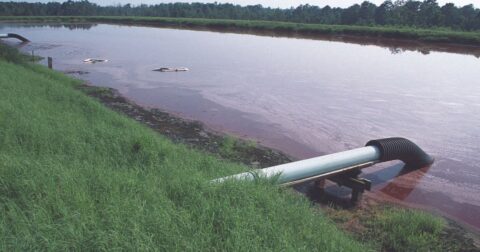Feature
The Sneaky Way Even Meat Lovers Can Lessen Their Climate Impact
Food•6 min read
Reported
Amid the World Pork Expo, the industry reframes "sustainability" and targets the very communities it pollutes.


Words by Jennifer Mishler
The pork industry is far from defeated. Despite its recent loss before the Supreme Court as it challenged even the most modest of animal welfare protections afforded by California’s Prop 12 — and lost — the industry is now poised to revamp its marketing strategy. And it’s looking to sell more to the very communities it harms the most.
Meat producers gathered in Des Moines, Iowa for the World Pork Expo last week, hosted annually by the National Pork Producers Council. The agenda for the event offers insight into the latest marketing strategies of the $57 billion pork industry, with seminar topics from “Is Gene Editing the Next Frontier?” to “Advancing Profits and Sustainability by Improving Pig Survivability” — and, perhaps the most telling title — “Because if You Aren’t Optimizing Profits, Nothing Else Matters.”
Like the beef and poultry industries, pork producers want to assure consumers that bacon and chops can still be sustainable, even as the industry pollutes the air and water. At the same time, pork producers are aiming to ease rising concerns over the health risks of eating pork, in part by marketing their products to the very consumers most affected by pollution — Black and brown communities in the U.S.
According to industry publication Farm Journal, the National Pork Board is angling to boost demand in the U.S. by targeting Hispanic, Black and Asian consumers. The Pork Board’s senior director of multicultural marketing, Jose De Jesus, indicated that the industry is looking to ease consumer doubts that pork is a healthy protein.
“While there’s a lot of love for pork and consumption of pork, there are some concerns that trace back to health,” said De Jesus.
Indeed, a growing body of evidence links bacon and other processed meats to an increased risk of cancer, and even unprocessed pork has been tied to a higher chance of coronary heart disease. Alarming new cardiovascular disease projections find heart disease is primed to rise 31 percent by 2060, disproportionately affecting Black and Hispanic communities.
The pork industry’s current focus is really just the latest in a longtime effort by the meat industry at large to aim its marketing at people of color, as many years of research shows. In 2008, data analysis published by the NIH revealed that “African Americans are consistently exposed to food promotion and distribution patterns with relatively greater potential adverse health effects than are Whites.” Meat and eggs as well as candy and soda, the researchers found, were more likely than fruits and vegetables to be advertised to Black audiences.
But consumers are starting to connect the dots. In 2020, a Gallup poll found that 31 percent of consumers who did not identify as white were eating less meat, and in recent years, data shows that Black Americans are going vegan at a faster-than-average rate.
Pork producers are working hard to assure climate-minded shoppers that their product doesn’t wreck the planet, as the industry aims to be seen as the maker of “the most sustainable meat.”
In 2022, a Kearney survey alerted producers to the “Dawn of the Climavore,” and found that the grocery store purchasing of 27 percent of respondents would be influenced by a food’s environmental impact. (Whether that sentiment translates into actual purchasing decisions, however, is less clear.)
Major pork producer Hormel is aiming to “demonstrate climate leadership” by reducing its emissions, water usage, packaging and other impacts by 2030. The industry at large has committed to lowering its climate emissions by 40 percent by that same year.
Yet the industry’s own sustainability reports also suggest climate progress for pork — that is, lowered climate emissions — are mostly achieved by what the industry describes as increases in “efficiency.” And that efficiency comes at a steep cost to the animals raised in these factory farms and the people that live in the surrounding areas.
The industry’s self-described “climate leadership” comes at huge cost to the communities living near pig farms — often Black and brown communities bearing the brunt of the air and water pollution caused by nitrates leaching into the water.
Industrial pig farms contain massive amounts of animal waste, often stored in open-air lagoons vulnerable to flooding. When waste spills or is misapplied to crop fields or runs off into surrounding waters, the resulting nutrient pollution from phosphorus and nitrogen can lead to massive algal blooms that kills marine life and makes the air and water toxic to the humans who live nearby.
The industry’s impacts can particularly be seen in North Carolina, the second largest pig producer in the nation. In 2022, a report found that 156 of the state’s two million pig farms were at risk for flooding. Of those large-scale farms, 26 were located in Duplin County, where over 19 percent of residents now live below the poverty line and are heavily impacted by air pollution from hog farms.
Four years earlier, residents who live alongside the Cape Fear river saw the floodwaters of Hurricane Florence breach factory farms in the region — drowning animals and flushing their waste into waterways. “During a flood event,” Stanley Riggs told the New York Times, “it’s like flushing a toilet.”
Little has changed. The pork industry has done virtually nothing to address hog farming pollution and the health risks that come with living close to pork production. Yet “the other white meat” continues to market itself as “sustainable” in new ways — now to Black and brown communities, as both climate-friendly and good for your health.